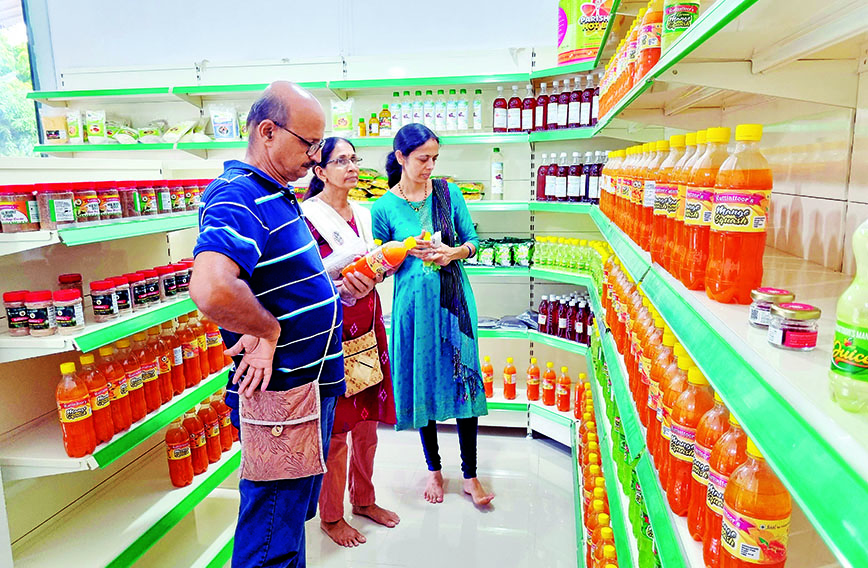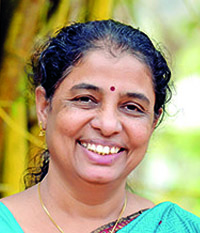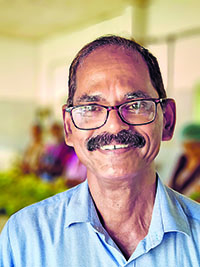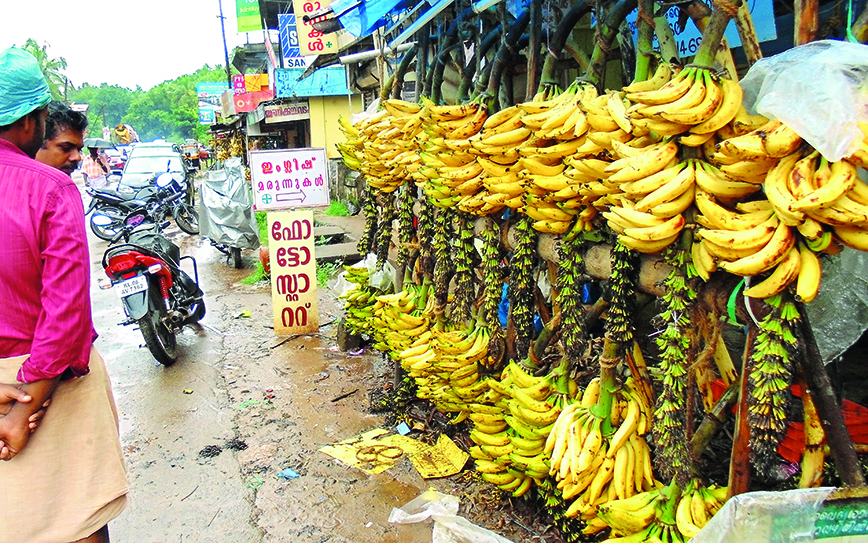
A contractor with his day’s harvest: The trees are tall and many growers find it easier to outsource the harvesting at a flat rate
When a great mango looks for a market
Shree Padre, Kasaragod
IN 2021, as the world struggled to shake off the Covid-19 pandemic, Kuttiattoor, a quiet village in Kerala, found itself basking in glory it hadn’t entirely anticipated. An eponymous mango which Kuttiattoor had been lazily growing for the longest time had earned the village a Geographical Indicator (GI) tag.
For the record, the village was suddenly famous — nationally and globally too — because the Kuttiattoor mango had now placed it in a firmament of distinctive products like Scotch, Champagne, Basmati, Darjeeling tea and Florida oranges.
The Kuttiattoor mango takes its name from the village of Kuttiattoor. It also grows in the neighbouring village of Maniyoor and in villages in 23 panchayats nearby. The GI tag applies to all of them. The mango is not cultivated in orchards, but grows dispersed in homesteads, underscoring the community ownership that a GI recognizes.
The trees are tall and they fruit in such abundance that as much as 50 percent of a season’s crop can go unharvested.
It is a wonderful mango — bright yellow, sweet, juicy and very fleshy. Even before the GI tag, it brought the village some degree of noticeability, being relished in adjoining districts and, at a stretch, in other parts of Kerala as well.
The GI status, however, put Kuttiattoor and its neighbours on an entirely different pedestal, providing recognition and opening up commercial possibilities local panchayat leaders couldn’t even begin to imagine. The villages now had an opportubity to take a moonshot at serious prosperity. What if all those mangoes could be sold at a pretty premium?
But sadly, two years later, the villages are exactly where they were before the recognition was bestowed on them. The price of the mango hasn’t gone up, the crop still goes to waste and attempts at creating value-added products like juice and jam have been slow.
How does a village, far removed from the wiles of the marketplace, pull off commercial deals and brand itself without funds and expertise? It is one thing to have a distinctive product and quite another to sell it.
For Kuttiattoor the challenge has been uphill. As a consequence, its name is hardly known. The anticipation that traders would arrive in droves to buy the mango has remained unfulfilled.
 The newly opened retail outlet on the road to the Kannur airport
The newly opened retail outlet on the road to the Kannur airport
Kuttiattoor continues to be just another tiny village in Kerala’s verdant landscape. It is both famous and unremarkable. You could pass through it without noticing its celebrated mango trees. Your eyes would glaze over the water bodies, paddy fields and hilly bits in the same way as towns and villages fly by in Kerala’s linear topography.
Kannur airport, just 13 km away, has been Kuttiattoor’s connection to the world at large with a good road providing easy access. But it doesn’t seem to have made any serious difference to the village.
Kuttiattoor panchayat’s 7,200 households, a population of some 30,000, seem largely content with growing rice, spices, some rubber and mining laterite soil for its rust-red stone. They don’t seem to want to put in the effort to make a success of the mango.
HANDHOLDING
The GI certification came with much handholding and guidance by the Kerala Agricultural University (KAU). Its intellectual property cell, led at the time by Dr C.R. Elsy, saw in the qualities of the mango and its dispersed cultivation by village households many of the factors needed for a GI certificate providing community ownership over the name.
 |
|
Dr M.R. Dinesh |
But much before KAU stepped in, a story done by Civil Society on Kuttiattoor in 2015 drew the attention of Dr M.R. Dinesh, the then director of the Indian Institute of Horticultural Research (IIHR).
A mango scientist himself, he took keen interest and along with his team visited Kuttiattoor. Kannur’s Krishi Vijnan Kendra (KVK) also got interested. A series of meetings was held under the leadership of the Kuttiattoor panchayat.
The IIHR team put forth very valid suggestions. It said Kuttiattoor’s big advantage is that the mango is harvested much before other mango varieties hit the market. The season begins in February and winds down in June. It has a first-mover advantage, so to speak, and substantial business can be booked.
Also, it is a large mango — just four mangoes make up a kilo. Since it is the first mango of the season to be ready for harvest, it can also be used as pulp. Existing pulp factories can start processing the mangoes a month before time if they get adequate supplies from Kuttiattoor.
“If you address problems like fruit fly and anthracnose attacks, you can brand your fruits and market the best ones in stalls along the road,” said the IIHR team.
The Kuttiattoor mango tastes like a regular mango, except that its flesh is not as firm as the Alphonso, Mallika or Neelam. Also, it doesn’t have as much fibre as the other local varieties. But it is not inferior in taste to popular varieties.
PRODUCER COMPANY
The panchayat listened keenly and by 2016 it set up the Kuttiattoor Mango Producers’ Company, which serves as a farmer-producer organization (FPO).
For the first time, the farmers were getting down to business together. But if there was a change in spirit among them, much foundational work remained to be done. They would need to understand marketing and finance. An odd retail store or a processing unit putting out a few products was not going to be enough.
For wider outreach, identity-building was required. A GI tag, as suggested by Dr Elsy, was really what they needed.
But a GI tag they were not going to get overnight. There were forms to be filled, scientific tests to be conducted and historical evidence to be provided.
Based on what she knew, Dr Elsy was fairly sure there was a good case for the mango, but she would have to build it by substantiating claims with facts. Nothing less would do.
Finally, when the GI application was filed it was based on the yellow colour of the Kuttiattoor mango, its sweetness, texture and nutritional values. Its uniqueness came from the water, soil and microclimate of the area in which it is grown.
 |
| Dr C. R. Elsy |
“When I heard about this mango, I thought maybe because of the large number of trees in each household there is some connection between the soil and environment and the variety. Some farmers contacted me also at that time saying it was a specific variety and that some studies had been done by Indian Institute of Horticultural Research,” recalls Dr Elsy about how her involvement began.
“I took permission from the university and gave a proposal to the State Department of Agriculture, which sanctioned the funds. We organized a meeting of farmers of that area as well as farmers from the nearby villages in Kannur district. It was a big meeting at which we discussed the possibility of GI registration,” says Dr Elsy about the process of informing the farmers about what they were getting into.
“One of my students did some work on the specific characters of this particular variety. It is an example of how an academic programme can benefit people,” she says.
Her students collected samples from multiple villages which were then tested at accredited laboratories. The information collected was used to make the application. They had to establish that this mango was special and, in being so, different to others.
It was documented that the mango was uniquely yellow when cut open. It was of medium sweetness. It wasn’t as fibrous as other mangoes. And its nutritional values were on a par.
 |
|
There are 20 trees that are being dwarfed in Kuttiattoor |
The Kuttiattoor mango also stood out for being poly-embryonic. From a seed came as many as 13 seedlings, which was a special characteristic. It also explained why the Kuttiattoor mango trees are fecund and provide a huge crop — much more than other mango trees.
“Poly-embryonic usually means from one seed you can get six or seven. But we counted up to 13 seedlings from a single seed. Normally this doesn’t happen. Some local varieties also have multiple seedlings. But I haven’t seen any local variety with up to 13 seedlings from a single seed,” says Dr Elsy.
Supported by documentation of the academic kind, the GI application went through. But the farmers now had to convert the GI status into better visibility and, deriving from that, bigger sales of the mango.
A long road remained ahead, but the opportunity too was huge. A dedicated census has not been done but according to one calculation, the villages of Kuttiattoor and Maniyoor that make up the Kuttiattoor panchayat produce about 5,000 tonnes of mangoes. Kuttiattoor village alone has some 25,000 trees. A big, old tree is known to deliver 100 kg in a season.
 |
|
V.O. Prabhakaran |
V.O. Prabhakaran, chairman of the Kuttiattoor Mango Producers’ Company, says: “If we calculate at the average consumer price of Rs 40 per kg, the Kuttiattoor panchayat produces an impressive Rs 16 crore to Rs 20 crore worth of mangoes every year.”
That should have made the 7,200 households of this panchayat rich, but it hasn’t. The producer company also hasn’t been able to fire the enthusiasm of local people. Of the 5,000 tonnes of mangoes estimated to be produced, last year the producer company was only able to procure and sell 20 tonnes.
The company lacks funds to invest in a building, equipment, marketing and outreach to growers so that it can be in a dominant position to increase the demand for the mango and the price that growers get.
“The local community’s involvement is not up to the mark,” complains Prabhakaran. “Our company has 515 shareholders. We have collected Rs 3 lakh as share capital. If more members join and buy shares, it empowers us to increase our services. If our share capital can be increased to Rs 15 lakh, we can get an equal matching grant from the government. But indications from our own people are far from encouraging.”
In the absence of the company making its presence felt, middlemen continue to be in control, buying an entire tree for just Rs 5,000 before the season begins and making a profit of Rs 30,000 or Rs 40,000 from it.
After receiving the GI status, the farmers had an opportunity to visit Delhi on a couple of occasions — first to receive the certification and again for a B2B event.
Both visits led to enquiries. One came from France for a large quantity of pulp and another from Turkey. Neither seems to have been formalized.
The farmers have a problem working their way through commercial arrangements. They aren’t fully conversant with English and don’t know how to pitch their mango.
Official patronage helps. But what they really need is savvy to deal with the world. Capital for infrastructure and marketing, and branding advice are required to make them more competitive.
 |
|
The value addition centre produces jam, pickle, squash and a few other products |
Under the guidance of the Kannur KVK, the small value-addition unit of the panchayat now produces 11 mango products. These include mango squash, mango ready-to-serve, jams from ripe and green mangoes, pickle, and amchur or mango powder.
The products are clearly aimed at a small local market. The export market is all about pulp and fresh fruit.
RETAIL STORE
A few months ago, the farmers did make a smart move. With the promise of financial help from the Kuttiattoor panchayat, the producer company inaugurated its own shop at Chattukappara along the airport road. Only Kuttiattoor mangoes and value-added products are being sold. Customers have begun showing up.
The outlet remains open till 9 pm. Its maximum turnover is Rs 20,000 per day. In fact, even during the monsoon, sales were Rs 5,000 per day.
Indian Railways has allowed the farmers to set up a shop at the local railway station. With limited displays, this shop too brings in around Rs 5,000 a day by way of sales.
But their stocks seem to be insufficient. “We have two tonnes of mango pulp and a large quantity of pickle this year. We hope our products last till the next season,” says Prabhakaran.
Production also fluctuates every year since it depends on climate and rainfall patterns. If there are showers during the flowering or fruiting season, mango production is adversely affected.
The company does supply fresh fruits, but to just six retail outlets. The mangoes are procured and naturally ripened using ripening chambers provided by the IIHR.
The company, however, doesn’t have the funds to buy larger quantities of mangoes during the season to meet additional demand. The value-addition unit, till recently, was functioning only during the fruiting season. Twelve women work in the unit. This year the company hopes to run it through the year.
A project to manufacture a mango carbonated drink and mango ice-cream has been on the anvil for some time now. The Agriculture Infrastructure Fund and a few other agencies have sanctioned Rs 59 lakh for this. The producer company has to just provide the building. But it doesn’t have one.
The block panchayat has a building which it is willing to hand over to the gram panchayat. The problem is that this building lacks power supply and water. Since the logjam continues, the gram panchayat is still without a building to house a factory.
The lack of working capital is frustrating. Generally, farmer producer organizations are given financial assistance of Rs 9 lakh to 11 lakh in the initial three years by the state’s agricultural department. The Kuttiattoor producer company got only Rs 3.25 lakh. It hasn’t got any other financial help.
Even if they were to buy more mangoes, the panchayat has no facility to store and grade the fruits. Despite demand, the fruits can’t be preserved beyond the season. A spacious cold storage would have increased farmers’ earnings.
 |
|
Dr P. Jayaraj |
“Although there is a producer company, it lacks essential infrastructure facilities. Decentralized procurement and grading are still a distant dream. If all this is possible, then a kilo of mangoes can be easily sold for Rs 80 to Rs 100 at the beginning of the season. During the peak season the price would go down to Rs 40,” says Dr P. Jayaraj, who heads the Kannur KVK.
The large size of the Kuttiattoor mango trees is a drawback. Climbing the trees and harvesting the entire crop is challenging. It requires expertise and charges can exceed Rs 1,000 a day.
A scientific solution exists in dwarfing the trees. In Maharashtra’s Konkan area, the Dr Balasaheb Sawant Konkan Krishi Vidyapeeth (BSKKV) at Dapoli has been dwarfing trees for a long time. It involves cutting the tree to a manageable height. Though the process looks simple, it requires care and expertise. The BSKKV has successfully ‘dwarfed’ thousands of Alphonso mango trees. It takes a couple of years for the trees to begin bearing fruit again. Future yields promise to be good, but the biggest advantage is that the mangoes can be harvested easily. By way of demonstration, 20 trees have been dwarfed in Kuttiattoor at a cost of Rs 2,500 per tree.
“Farmers have shown an interest. There are some other advantages of dwarfing. Loranthus, a parasitic plant that grows on mango trees and affects production, gets destroyed. As we have cut only the trees selected as best cultivars, we get a huge number of scions from which we could produce grafts,” points out Dr Jayaraj.
Prabhakaran describes dwarfing as a turning point. He says: “Not only Kuttiattoor’s farmers, but also those from nearby panchayats are contacting us. We want to carry out this ‘shortening’ of trees in their areas too. Once trees bear fruit again, even ordinary labourers can do the harvesting.”
LIMITED POSSIBILITIES
There is unmet demand at Kuttiattoor so the opportunity to do better exists. But Dr Elsy cautions that with GI tag products, the possibilities are always limited. Such products are circumscribed by their very uniqueness and volumes remain low. If bigger profits are to be made it is through a premium for which quality and identity are important.
 The Chengalikodan banana sells at a premium
The Chengalikodan banana sells at a premium
Dr Elsy’s IP cell at KAU has helped many groups of farmers get GI status for different natural products. But creating demand for the products is an altogether different proposition.
A success story is that of the Chengalikodan banana. Its uniqueness because of its red colour and the shape of its combs was already well known before it earned its GI status.
But GI recognition created a buzz and made it yet more famous, resulting in bigger demand beyond Kerala. Locally, it is the banana to offer at the Guruvayoor temple and on important religious occasions all kinds of fancy prices are paid for a comb.
There are limitations to how many Chengalikodan bananas can be grown in the same geographical area. But because it is admired and sought after better value is derived from the premium that gets charged.
This then is the opportunity that beckons the producers of the Kuttiattoor mango. It needs to build on its iconic identity. Greater volumes would be possible if 40 percent of the harvest were not allowed to go to waste. But better prices won’t happen until buyers begin asking for the mango not just in Kerala but across India and the world.
Comments
Currently there are no Comments. Be first to write a comment!




